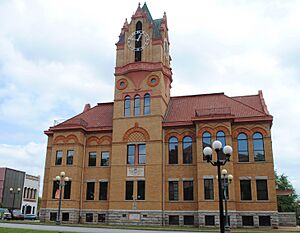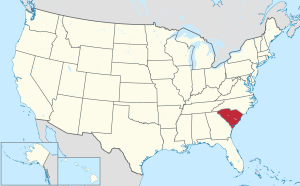Anderson County, South Carolina facts for kids
Quick facts for kids
Anderson County
|
|||||
|---|---|---|---|---|---|

Anderson County Courthouse
|
|||||
|
|||||
| Motto(s):
"Experience, Excel, Enjoy In Anderson County, SC"
|
|||||

Location within the U.S. state of South Carolina
|
|||||
 South Carolina's location within the U.S. |
|||||
| Country | |||||
| State | |||||
| Founded | 1826 | ||||
| Named for | Robert Anderson | ||||
| Seat | Anderson | ||||
| Largest community | Anderson | ||||
| Area | |||||
| • Total | 755.76 sq mi (1,957.4 km2) | ||||
| • Land | 713.85 sq mi (1,848.9 km2) | ||||
| • Water | 41.91 sq mi (108.5 km2) 5.55% | ||||
| Population
(2020)
|
|||||
| • Total | 203,718 | ||||
| • Estimate
(2023)
|
213,076 |
||||
| • Density | 269.5538/sq mi (104.0753/km2) | ||||
| Time zone | UTC−5 (Eastern) | ||||
| • Summer (DST) | UTC−4 (EDT) | ||||
| Congressional district | 3rd | ||||
Anderson County is a county in South Carolina, a state in the United States. In 2020, about 203,718 people lived there. The main town, or county seat, is Anderson.
The county is named after Robert Anderson. He was a leader during the American Revolutionary War. Anderson County is in the northwestern part of South Carolina. It is right next to the state of Georgia.
This area is part of a larger region called the Greenville-Anderson-Greer Metropolitan Area. A big part of the county is Lake Hartwell. This lake has almost 1,000 miles of shoreline. People use it for homes and fun activities. Anderson County is also growing as a place for businesses and tourism. It is home to Anderson University, a school with about 4,000 students.
Contents
History of Anderson County
Anderson County was created in 1826. It was formed after the Pendleton District was divided. The county got its name from Robert Anderson. He was a general during the American Revolutionary War.
During the American Civil War, Anderson County was important. It made supplies for the army. The county seat and largest city is Anderson. Both the county and city are in the Greenville-Anderson-Greer area.
Farming has always been a big part of the county's history. Anderson County is known for its farms. It grows crops like cotton, corn, and many fruits and vegetables. It also has a large poultry industry, raising chickens and other birds.
Geography and Nature
Anderson County covers about 755.76 square miles. Most of this area, about 713.85 square miles, is land. The rest, about 41.91 square miles, is water. This means about 5.55% of the county is water.
The county is located in two important river areas. These are the Savannah River basin and the Saluda River basin.
Protected Natural Areas
Anderson County has several special places. These areas are protected for nature and recreation:
- Broyles Recreation Area
- Fant's Grove Wildlife Management Area
- Sadlers Creek State Park
Main Rivers and Lakes
Here are some of the major water bodies in Anderson County:
Neighboring Counties
Anderson County shares borders with several other counties:
- Pickens County – to the north
- Greenville County – to the northeast
- Laurens County – to the east
- Abbeville County – to the south
- Elbert County, Georgia – to the southwest (in Georgia)
- Hart County, Georgia – to the west (in Georgia)
- Oconee County – to the northwest
Major Roads
Many important highways run through Anderson County:
 I-85
I-85 US 29
US 29 US 76
US 76 US 178
US 178 SC 8
SC 8 SC 20
SC 20 SC 24
SC 24 SC 28
SC 28 SC 81
SC 81 SC 88
SC 88 SC 187
SC 187 SC 252
SC 252 SC 247
SC 247
Important Facilities
- Anderson Regional Airport
People of Anderson County (Demographics)
| Historical population | |||
|---|---|---|---|
| Census | Pop. | %± | |
| 1830 | 17,169 | — | |
| 1840 | 18,493 | 7.7% | |
| 1850 | 21,475 | 16.1% | |
| 1860 | 22,873 | 6.5% | |
| 1870 | 24,049 | 5.1% | |
| 1880 | 33,612 | 39.8% | |
| 1890 | 43,696 | 30.0% | |
| 1900 | 55,728 | 27.5% | |
| 1910 | 69,568 | 24.8% | |
| 1920 | 76,349 | 9.7% | |
| 1930 | 80,949 | 6.0% | |
| 1940 | 88,712 | 9.6% | |
| 1950 | 90,664 | 2.2% | |
| 1960 | 98,478 | 8.6% | |
| 1970 | 105,474 | 7.1% | |
| 1980 | 133,235 | 26.3% | |
| 1990 | 145,196 | 9.0% | |
| 2000 | 165,740 | 14.1% | |
| 2010 | 187,126 | 12.9% | |
| 2020 | 203,718 | 8.9% | |
| 2023 (est.) | 213,076 | 13.9% | |
| U.S. Decennial Census 1790–1960 1900–1990 1990–2000 2010 2020 |
|||
In 2020, the population of Anderson County was 203,718 people. There were about 75,825 households, which are groups of people living together. About 52,038 of these were families.
Most people in Anderson County are White. In 2020, about 74.81% of the population was White. About 14.83% were Black or African American. Other groups like Asian, Native American, and people of mixed races also live here. About 4.70% of the population was Hispanic or Latino.
In 2010, the average age of people in the county was 39.7 years old. The average income for a household was about $42,871 per year. For families, the average income was about $53,229 per year. About 15.8% of the people lived below the poverty line. This included 23.0% of those under 18 years old.
Economy and Jobs
In the past, Anderson County was known for its textile mills. These factories processed cotton grown in the South. Today, the county has many different types of businesses. There are over 230 manufacturers here. This includes 22 companies from other countries.
The main industries in Anderson County are:
- Making car parts
- Producing metal products
- Building industrial machines
- Working with plastics
- Publishing
- Textiles (fabrics)
The area is a big center for car parts. There are over 27 suppliers for BMW cars in the region. The plastics industry is also very strong. Anderson County has 27 plastic companies within its borders.
Top Employers
As of April 2024, some of the largest employers in Anderson County include:
- AnMed Health Medical Center (a hospital)
- Anderson University
- Bosch (a technology company)
- The City of Anderson
- Glen Raven, Inc. (a fabric company)
- Ingles (a grocery store chain)
- Michelin (a tire company)
- Walmart (a retail store)
- Walgreens (a pharmacy)
The unemployment rate in the county has been around 3% in recent years. In 2022, the total value of goods and services produced in the county, called GDP, was about $9.1 billion.
Communities in Anderson County
Anderson County has several different types of communities.
Cities
- Anderson (This is the county seat and the largest community.)
- Belton
- Clemson (Most of this city is in Pickens County.)
- Easley (Most of this city is also in Pickens County.)
Towns
- Honea Path (Part of it is in Abbeville County.)
- Iva
- Pelzer
- Pendleton
- Starr
- West Pelzer
- Williamston
Census-Designated Places (CDPs)
These are areas that are like towns but are not officially incorporated as cities or towns.
- Centerville
- Fair Play (Mostly in Oconee County.)
- Homeland Park
- La France
- Northlake
- Piedmont (Partly in Greenville County.)
- Powdersville
- Sandy Springs
Unincorporated Communities
These are smaller communities that are not part of any city or town.
- Cheddar
- Craytonville
- Piercetown
- Townville (Partly in Oconee County.)
Education
Anderson County has several school districts that serve its students:
- Anderson School District 1
- Anderson School District 2
- Anderson School District 3
- Anderson School District 4
- Anderson School District 5
See also
 In Spanish: Condado de Anderson (Carolina del Sur) para niños
In Spanish: Condado de Anderson (Carolina del Sur) para niños




